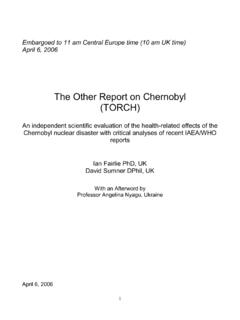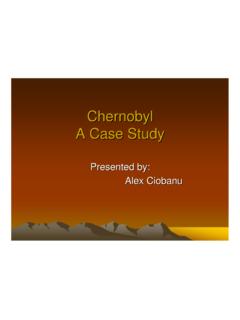Transcription of RESPONSES AFTER CHERNOBYL AND FUKUSHIMA - Laka.org
1 Published March 5, 2012 (first published in Nuclear Monitor 743) RESPONSES AFTER CHERNOBYL AND FUKUSHIMA COMPARATIVE ANALYSIS OF GERMANY AND THE NETHERLANDS AS AMPLIFIED EXAMPLES. The worldwide reactions on the nuclear disaster at CHERNOBYL (Ukraine, 26 April 1986) were quite different in different countries. So were the worldwide reactions on the nuclear disaster at FUKUSHIMA (Japan, 11 March 2011). On both governmental level as well as on a public level. This article is a comparative overview of the worldwide RESPONSES two both disasters, with (West-) Germany and the Netherlands as amplified examples. It is clear it will take some time to analyze the precise consequences of the FUKUSHIMA nuclear disaster on a political level, as well as for the future of nuclear power in general.
2 Nevertheless, this is a first attempt, focusing on the differences compared to CHERNOBYL in two neighboring countries. But first a brief overview of the worldwide RESPONSES . Reactions AFTER CHERNOBYL AFTER CHERNOBYL many countries decided to cancel the (planned) construction of (new) nuclear power plants. Italy was the only country which decided to close their nuclear power plants AFTER a 1987 referendum. The shutdowns of the East-German nuclear power plants during the German reunification (1990) and Lithuania's only nuclear power plant Ignalina (2009) a CHERNOBYL -type reactor - in accordance with Lithuania's accession agreement to the European Union could be considered as a delayed impact of the accident in CHERNOBYL .
3 CHERNOBYL caused much fear among the public and has seriously limited the worldwide expansion of nuclear capacity for a long time. AFTER CHERNOBYL until now, only China, Iran, Mexico and Romania have completed construction of their first nuclear reactors and thereby entering the select group of countries with nuclear power reactors. Particularly in the United States the partial melt-down in one of the reactors of the Three Mile Island (TMI) nuclear power plant in Harrisburg (29 March 1979) had grave consequences. The support for nuclear power dropped substantially in the United States and elsewhere in the world, which was again amplified AFTER CHERNOBYL .
4 However, there were and there are also many other factors involved on influencing the state of the nuclear capacity. On the one hand the oil shocks in the 1970s led to renewed concerns about energy security. For example as a consequence of the oil crisis of 1973-4 France started to launch a large nuclear energy program to diversify its economy away from oil. On the other hand, skyrocketing oil prices led to global inflation and high interest rates making nuclear power much less competitive. High inflation led to sagging economies and falling demand for electric power making earlier assessments of electric power supply/demand projections obsolete.
5 Such periods of economical crises happened in the 1970s, in the early 1980s, the years AFTER Harrisburg, and again with the nuclear disasters at FUKUSHIMA in 2011. Only many years AFTER CHERNOBYL , from the end of the 1990s, the (worldwide) support for nuclear power started to grow, because nuclear energy was presented as a carbon neutral energy source that would be of great importance to reduce the carbon dioxide emissions. More and more people began to believe in nuclear power as an option to reduce these emissions, although worldwide support for nuclear power has always been limited. In a whole range of non-nuclear nations in February 2012 according to the World Nuclear Association nearly 45 countries - a nuclear power program is "under serious consideration".
6 A remarkable (and highly unrealistic) number when you keep in mind that only 10 countries started to generate nuclear energy for the first time since the end of the 1970s; AFTER the accident at Three Mile Island. (see Table 1) That means that not a single country started a nuclear power program (the construction of its first nuclear power reactor) since CHERNOBYL ; in fact, only two (China and Romania) AFTER the 1979 accident at TMI. Table 1: Emerging nuclear countries Country Start construction first NPP First power of first reactor Number of reactors (as of January 2012) Slovenia1 3-1975 10-1981 1 Brazil 5-1971 4-1982 2 Hungary 8-1974 12-1982 4 Lithuania2 5-1977 12-1983 - South Africa 7-1976 4-1984 2 Czech Republic3 1-1979 2-1985 6 Mexico 10-1976 4-1989 2 China 3-1985 12-1991 16 Romania 7-1982 7-1996 2 Iran 5-1975 11-2011 1 1 By then part of Yugoslavia; 2 By then part of the Soviet Union.
7 3 By then part of Czechoslovakia Even in the past decade long before FUKUSHIMA - it was already clear that nuclear energy can t be a panacea for carbon reductions in the future. This cheap PR trick of the nuclear industry is aimed to generate a nuclear renaissance. But unsuccessfully: there was no nuclear renaissance (see Table 2). As of march 1, 2012, there were 436 nuclear reactors operating in the world - eight fewer than in 2002. The International Atomic Energy Agency currently lists 63 reactors as under construction in 14 countries. By comparison, at the peak of the industry s growth phase in 1979, there were 233 reactors being built concurrently.
8 In 1987, 137 reactors were listed under construction. In 2008, for the first time since the beginning of the nuclear age, no new unit was started up, while two were added in 2009, five in 2010, and seven in 2011. In the European Union, as of March 1, 2012, there were 143 reactors officially operational, down from a historical maximum of 177 units in 1989. Table 2: Number of reactors 1979, 1987, 2012 Nuclear Power Status 31-12-1979 31-12-1986 31-12-2011 Units in Operation Total net MWe 234 120,427 396 272,315 435 368,000 Units Under Construction Total net MWe 226 205,700 137 121,645 63 61,000 Source: IAEA / ENS Reactions AFTER FUKUSHIMA Just like with CHERNOBYL , the worldwide political reactions on the nuclear disaster at FUKUSHIMA (Japan, 11 March 2011) were quite different too.
9 A group of countries with a large share of nuclear power, such as China, France, Russia, the United States and the United Kingdom don t have any intentions to end their nuclear programs. Other countries with a large share of nuclear power have shut down older nuclear reactors (Germany, Japan) and have announced to finish their nuclear programs. Germany says that all nuclear power stations will be closed in 2022 and Switzerland in 2034. Japan hasn t fixed a date, but declared to stop building new nuclear power reactors. The French Parti Socialiste (Social Democrats) and the French Greens have agreed upon a joint position on the future of France s nuclear power.
10 The Greens will support the PS candidate Fran ois Hollande in the next spring s presidential elections in return for his promise to shutdown 24 nuclear reactors by 2025, lowering France s dependence on atomic power to 50 percent, and the immediate halt of the oldest plant at Fessenheim. Italy has declared again by referendum to remain a non-nuclear nation. There are also non-nuclear nations and nations with little share of nuclear power which declare to go on as usual with their nuclear ambitions, such as Czech Republic, Turkey, Lithuania and the Netherlands. They argue that earthquakes like in Japan don t exist in their areas and that the new generation of nuclear power reactors is much safer than the 1971 built nuclear power station at FUKUSHIMA Daiichi.









